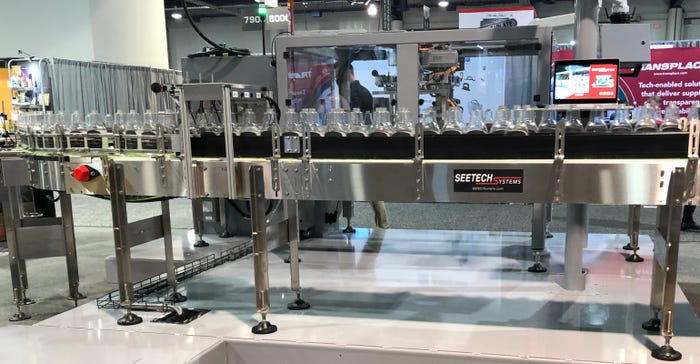Why Not Design Packaging Machines to be Closer to the Floor?
Hmm … With floorspace always at a premium, what can we do with all the empty space underneath most packaging machines?

How could we make better use of that empty space below the machine?Photo taken by Lisa Pierce at Pack Expo Las Vegas 2021
Go into the manufacturing plant and look at your packaging lines. Or, more specifically, look underneath your machines. Notice anything? As packaging equipment has embraced electronic motion control and advanced automation technologies, the wires, gears, and mechanical parts have disappeared. Many machines now are empty from waist-level down except for support legs.
I noticed this when I was walking around the 2021 Pack Expo Las Vegas show at the end of September (see the slideshow of images proving this).
Then I stopped at the Syntegon booth and saw how its ACE (Advanced Carton Erector) was redesigned with a Beckhoff AMP integrated servo drive at the top of the machine frame, proving that newer advanced machinery components can be positioned more flexibly than before. The AMP drive and control system is decentralized so there’s no need for a cabinet.
I’ve been asking machinery manufacturers for a couple years how they’ve changed their machine designs to take advantage of the improvements in machinery components. Except for admitting that their machines are more compact, no one (other than Syntegon) has reimagined their basic machine design, in my opinion. Admittedly, except for attending WestPack 2021 in August and Pack Expo Las Vegas 2021 in September, I haven’t seen a whole lot of packaging machines in person for the last two years, thanks to COVID-19.
Still. I have to ask … do automated packaging functions have to occur horizontally at waist level? Think of all the expensive and difficult-to-source-now metal and guarding materials we’d save by shortening the legs.
That low-level empty space is wasted, especially when you consider that:
1. Packaging machine components are more compact and can process linear and rotary motion differently today. How can packaging functions (container orienting, filling, capping, labeling, coding, case packing, and more) be performed differently now because of these updated technologies?
2. Packaging lines are more fully automated, with little or no human operator interaction. Waist level isn’t as important as it was (see “kinks” below).
3. Vertical form-fill-seal systems are far more floorspace-economical than other package filling operations, with “vertical” the essential word.
4. How many packaging machines tout their small size now? There’s demand for compact machines for good reason. Manufacturing plants need to do more with less. They need more output in the same space, or in less space.
5. In road building, a stacked interchange is the most land-efficient and “due to the relatively gentle curve of the interchanges ramps, it is efficient and most important safe at dealing with large traffic from all directions.” What can machinery designers learn from this regarding the flow of packages and footprint?

Granted, some kinks in my proposal still need to be ironed out.
For example, sanitation issues. And maintenance would be a pain, literally. Even with kneepads and a back brace, the typical maintenance technician would be uncomfortable (at best) trying to fix or maintain a machine if he/she had to work on the ground. Even clearing a jam would be taxing on a human. Maybe this is job for remote-controlled robots? If ’bots can disarm bombs, they should be dexterous enough to work on a packaging machine, right?
My point is… Let’s rethink the space needed for packaging operations to be done. Can we go up and down or serpentine instead of horizontally? As long as the motion is smooth and the container/package is securely handled throughout, there is nothing in the design rule book that says we can’t creatively use far more three-dimensional space.
About the Author(s)
You May Also Like




